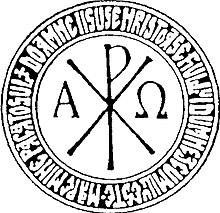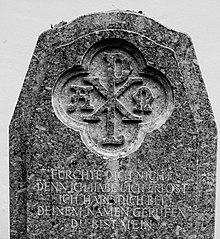Alpha and Omega

Alpha and Omega (Α and Ω) , the first and the last letter of the classical Greek alphabet , are a symbol for the beginning and the end, thus for the comprehensive, for God and especially for Christ as the first and last. Alpha and Omega often appear as accompanying motifs to the Christ monogram .
Biblical origin

In the Revelation of John (chap. 22:13) the exalted Jesus Christ describes himself as “the alpha and the omega, the first and the last, the beginning and the end.” In this self-conception of Christ, three pairs of terms are taken up that already mentioned earlier in Revelation. On the one hand, God describes himself as “Alpha and Omega” (τὸ ἄλφα καὶ τὸ ὦ; Rev 1,8 and 21,6) and as “beginning and goal” (ἡ ἀρχὴ καὶ τὸ τέλος; Rev 21,6 and according to some manuscripts also in 1.8). On the other hand, Christ presented himself in Rev 1.17 and 2.8 as “first and last” (ὁ πρῶτος καὶ ὁ ἔσχατος). The combination of the three pairs of terms in Rev 22:13 as Christ's self-conception indicates Christ's essential identity with God. This essential identity establishes his function as judge in the context of Rev 22:13 (Rev 22:12).
The traditional historical background of the God or Christ attribute "Alpha and Omega" in the Revelation of John is the God attribute "first and last" that occurs repeatedly in the second part of the book of Isaiah (Isa 44,6: רִאשׁוֹן and אַחֲרוֹן, similar: Isa 41,4 and 48.12). Revelation probably takes this attribute of God directly from the Hebrew text of the passages mentioned and places it in Rev 22:13 (cf. Rev 1:17 and 2,8) right next to the Christ attribute "the alpha and the omega". Alpha and Omega appear as a “concise and clear description” of the Old Testament “first and last”.
Thus, also with the second connected Christ or God attribute “beginning and end” (Rev 22:13 cf. 21,6), the meaning of the attribute “the alpha and the omega” in the Revelation of John can be understood quite well : Christ and God are “the beginning and the end, the creator and the finisher, who, 'from which and to which' everything is”. According to Revelation, God and Christ are those "who embrace all reality and therefore have power over all reality".
distribution
The cipher Alpha and Omega spread rapidly in the post-New Testament period. Through a supplementary text or an emblem, the expression always refers to Jesus Christ. The oldest example of the early spread could be the Rotas Opera Square from Pompeii , that is, before 79 AD. Like the sator square that was widespread in antiquity, it offers a symmetrical arrangement of five by five letters in a square. When reassembled, the letters result in two paternosters and two AOs. In the 2nd century Irenäus and Clemens offer us evidence of the spread of the expression in Gnostic circles that speculated about letters.
Its use probably dates back to before Constantine . In the 4th century it is particularly common in mainland Greece and in Asia Minor , Palestine , Arabia and Nubia , Italy , Gaul and North Africa . The symbols are mainly found on grave inscriptions, sarcophagi and in liturgical books, later also on amphorae and other vessels, on rings and coins, bricks and numerous objects of daily use. On frescoes of the catacombs in Rome (Santo Poziano, Santi Pietro e Marcellino), Naples (S. Gennaro) and Syracuse Α and Ω do not appear before the 5th century. The mosaic in S. Aquilino, Milan , and the cross medallion in the apse mosaic of the Church of Sant'Apollinare in Classe , Ravenna , are among the most famous representations.
In today's linguistic usage, the combination of the corresponding Latin letters "the A and O" is often used as a metaphor for "the basic principles" or "the quintessence" etc.
heraldry

- Alpha and Omega in the coat of arms are a common figure in heraldry and are primarily to be found in the coats of arms of bishops and similar spiritual persons. The two Greek letters symbolize the beginning and the end. There are two possibilities of representation in a coat of arms: either the letters are simply placed in the shield, or they are shown in an open book - according to the heraldic representation, the alpha on the right and the omega on the left.
- The alpha and omega is inscribed in the logo of the Jesus Freaks so that it resembles the anarcho sign .
See also
- Alpha et Omega , a Rosicrucian order founded in 1903.
literature
- Gerhard Kittel : ΑΩ. In: Gerhard Kittel (Hrsg.): Theological dictionary for the New Testament. Volume 1. Kohlhammer, Stuttgart et al. 1933, pp. 1-3.
- Ernst Lohmeyer : Art. Alpha and omega . In: Real Lexicon for Antiquity and Christianity . Volume 1. Hiersemann, Stuttgart 1950, Col. 1-4.
- Traugott Holtz: Alpha Omega. In: Horst Balz (Hrsg.): Exegetical dictionary for the New Testament. Volume 1. 2., improved edition. Kohlhammer, Stuttgart et al. 1992, ISBN 3-17-011205-8 , Sp. 155–156, (further literature there).
- Otfried Hofius : The testimony of the Revelation of John of the divinity of Jesus Christ. In: Hubert Cancik u. a. (Ed.): History - Tradition - Reflection. Festschrift for Martin Hengel on his 70th birthday. Volume 3: Hermann Lichtenberger (Ed.): Early Christianity. Mohr, Tübingen 1996, ISBN 3-16-146677-2 , pp. 511-528.
- Wolfgang Menzel: A . In: Christian symbolism . First part. Manz, Regensburg 1854, p. 1.
- Jan A. du Rand: Alpha and Omega I. New Testament . In: Encyclopedia of the Bible and Its Reception 1, De Gruyter, Berlin [et al.] 2009, 850–852 (accessed via De Gruyter Online).
- Georg Stuhlfauth : AO . In: Real Lexicon on German Art History . Vol. 1, 1933, Col. 1-5.
- A and O. In: Johann Heinrich Zedler : Large complete universal lexicon of all sciences and arts . Volume 1, Leipzig 1732, columns 5-7.
Web links
References and comments
- ↑ All ancient text witnesses offer ἄλφα (alpha) as a word and ὦ (omega) as a symbol. The name ὦ μέγα ( Omega ) came about much later (around the 7th century [so you Rand, 850]) and at the time of the NT could only be written as a symbol (ὦ) (Kittel, p. 1, note 1 ). Latin manuscripts use the Greek letters α and ω (du margin 850).
- ↑ The Septuagint does not reproduce אַחֲרוֹן with ἔσχατος in any of the places mentioned. Hence the seer John refers directly to the Hebrew text by using ἔσχατος for אַחֲרוֹן (cf. Kittel, p. 2).
- ↑ See Kittel, p. 1 line 17 f.
- ↑ Otto Böcher : The imagery of the Apocalypse of Johannes. In: Die Macht der Bilder (= Yearbook for Biblical Theology. Vol. 13). Neukirchener Verlag, Neukirchen-Vluyn 1998, ISBN 3-7887-1685-1 , p. 96.
- ↑ Kittel, p. 1, lines 10f. (in the original italics).
- ↑ Holtz, Col. 156.
- ↑ See Lohmeyer, Sp. 2.
- ↑ So the interpretation and execution in: Franz Dornseiff : Das Rotas-Opera-Quadrat. In: Journal of New Testament Science and Knowledge of the Older Church. Vol. 36, 1937, ISSN 0044-2615 , pp. 222-238; Monica-Elena Herghelegiu: See, he comes with the clouds! Studies on the Christology of the Revelation of John (= European University Writings. Series 23: Theology. Vol. 785). Lang, Frankfurt am Main et al. 2004, ISBN 3-631-51764-5 , pp. 149–151 (also: Tübingen, Univ., Diss., 2002).
- ↑ Clemens, Stromateis 6, 141, 6; Irenäus, Adversus haereses I 14.6; I 15.1f.



